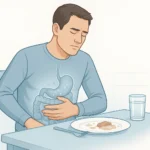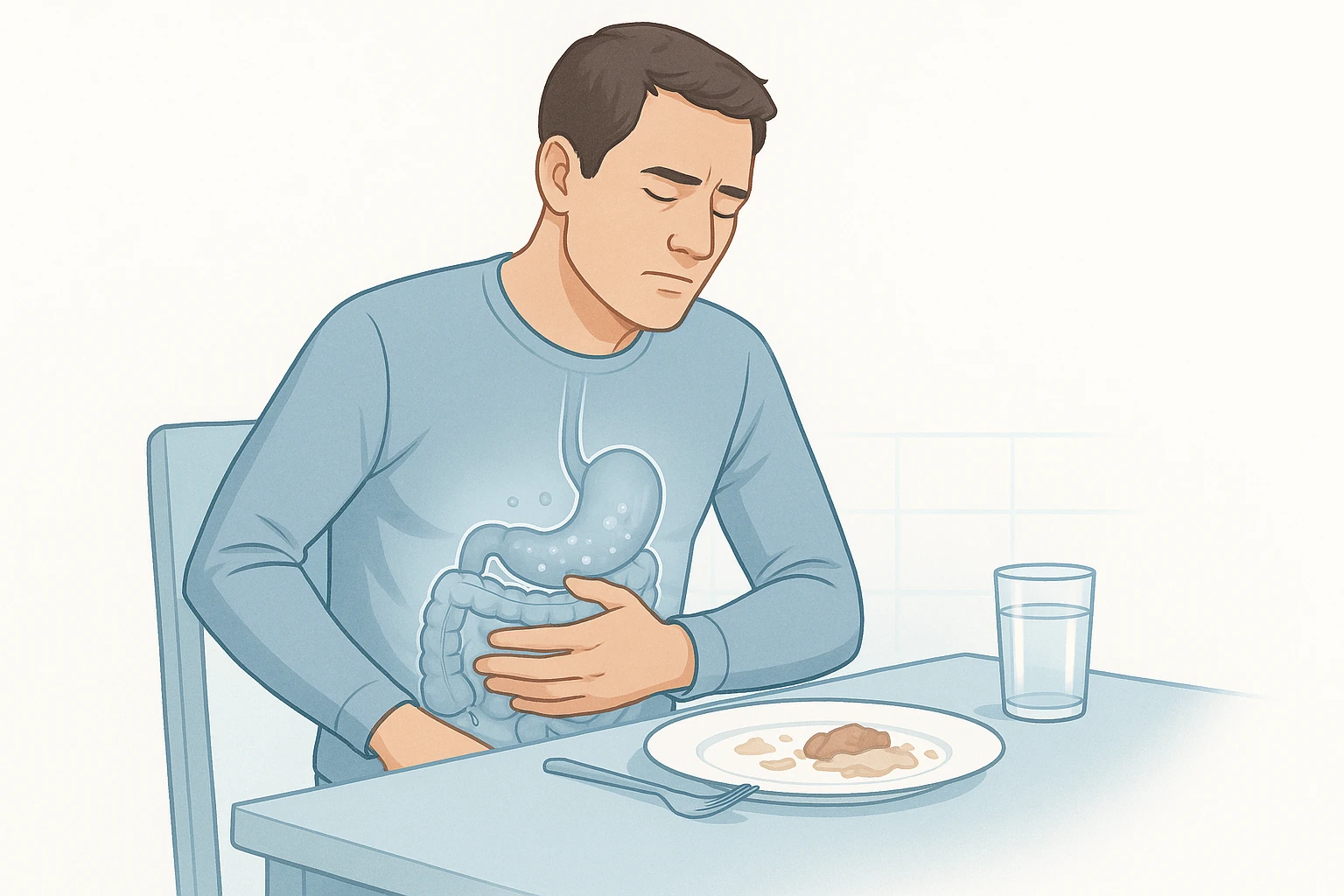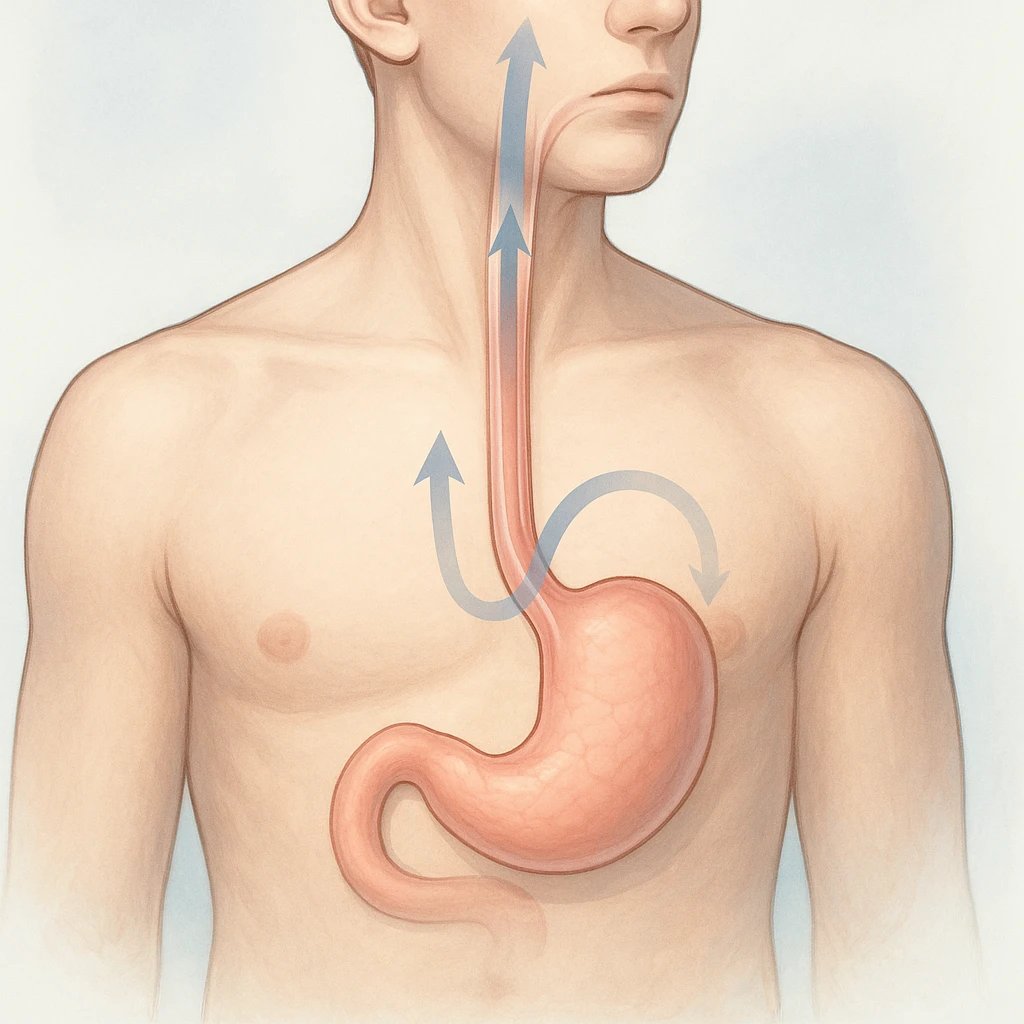
How to Recognize and Manage Gas Pain
Gas and Gas Pain
Gas is a natural part of digestion, and nearly everyone experiences it throughout the day. In most cases, gas moves through the digestive system quietly and is released without causing discomfort. However, when gas builds up or becomes trapped, it can lead to sensations of pressure, bloating, or pain. Understanding where gas comes from and how the body handles it can help make these symptoms feel less confusing or concerning.
How Gas Forms in the Digestive System
Gas forms in the digestive tract from two main sources. The first is swallowed air, which can enter the body during everyday activities like eating, drinking, talking, or even simply breathing. The second source is the natural activity of bacteria in the intestines. As these bacteria break down undigested carbohydrates from food, they produce gas as a byproduct. This process is a normal and ongoing part of digestion.
- Swallowed air from eating, drinking, and speaking
- Gas produced by intestinal bacteria during food digestion
The body releases gas primarily through belching and passing gas rectally. These are routine bodily functions that help maintain comfort and balance in the digestive tract. Having some gas is not only expected but also a sign that the digestive system is functioning normally.
What Normal Gas Patterns Look Like
While gas can sometimes feel embarrassing or inconvenient, passing gas multiple times a day is completely normal. Many people release gas throughout the day, and doing so between roughly 13 and 21 times daily falls well within the typical range. The exact amount can vary based on what you eat, how quickly you eat, and how your digestive system responds to different foods.
Gas becomes uncomfortable when it gets trapped or moves slowly through the intestines. This can create a sense of pressure or fullness. Understanding that these sensations are common and often temporary may help reduce stress or worry when they happen.
How Gas Pain Feels
Gas pain can feel different from person to person. Some describe it as a sharp cramp, while others feel more of a stretching or fullness in the abdomen. The sensation may shift or move around as gas travels through the digestive tract. Bloating, belching, and increased flatulence often occur alongside this discomfort.
- Cramping or sharp abdominal pain
- Fullness or bloating
- Belching
- Increased passing of gas
Although these sensations can be unpleasant, they are usually not harmful. Recognizing the pattern and nature of gas pain can help distinguish it from other types of abdominal discomfort and support a clearer understanding of what your body is experiencing.
Why Gas Pain Happens
Gas pain often develops when air or gas builds up within the digestive tract faster than the body can release it. This can happen for many everyday reasons, including how we eat and the types of foods we choose. Understanding these factors can help make gas symptoms feel less mysterious and provide a clearer sense of what may be contributing to discomfort.
Eating and Swallowing Air
One common reason gas accumulates is aerophagia, which refers to swallowing air. This can happen more frequently during rapid eating, talking while eating, or drinking through straws. These habits introduce extra air into the stomach, and some of that air travels into the intestines.
- Rapid eating
- Talking while eating
- Drinking through straws
- Carbonated beverages adding swallowed air
Carbonated beverages can have a similar effect. The bubbles in soda, sparkling water, and other fizzy drinks contain gas that can increase the amount of air in the digestive tract. When swallowed air or gas from carbonated drinks moves through the intestines, it can create a sense of fullness or pressure.
Food Fermentation in the Gut
The digestive tract is home to many helpful bacteria that break down components of the foods we eat. When certain carbohydrates are not fully digested in the small intestine, they move into the colon, where bacteria work to ferment them. This fermentation process naturally produces gas as a byproduct.
The more undigested carbohydrate that reaches the colon, the greater the potential for gas buildup and bloating.
Common Dietary Triggers
Some foods are known to contribute to increased gas production for many people. High-fiber foods, while nutritious, can sometimes lead to more gas as the body works to digest them. Certain fermentable carbohydrates, including lactose and other sugars in some fruits, vegetables, grains, and dairy products, can also be difficult to digest fully.
- High-fiber foods
- Lactose-containing dairy products
- Certain fruits and vegetables
- Wheat- and grain-based products
Recognizing personal patterns can help a person make informed adjustments without eliminating nutritious foods entirely.
When Gas Pain Is Part of a Bigger Picture
Gas pain is common and often relates to everyday digestive processes. However, for some people, gas discomfort can be part of a broader pattern linked to underlying digestive conditions. Understanding these connections can help clarify when symptoms may benefit from further discussion with a healthcare professional.
Conditions Linked to Gas Pain
Irritable bowel syndrome (IBS) and carbohydrate malabsorption are commonly associated with recurring gas-related discomfort. IBS involves a more sensitive digestive tract, meaning normal gas movement may feel more intense. Carbohydrate malabsorption, including lactose intolerance, occurs when certain sugars are not fully broken down in the small intestine.
- Irritable bowel syndrome (IBS)
- Lactose intolerance and other forms of carbohydrate malabsorption
- Bloating or cramping patterns linked to specific foods
How Clinicians Evaluate Gas Symptoms
A clinician may begin by reviewing diet habits, timing of symptoms, bowel patterns, and recent changes. This helps determine whether gas symptoms fit a pattern of typical digestion or conditions such as IBS.
- Diet and symptom history
- Patterns related to meals or specific foods
- Presence of other digestive symptoms
When Tests Are Helpful
When symptoms are persistent, unusually severe, or do not follow typical patterns, targeted testing may be considered. Testing may explore how the digestive system handles certain carbohydrates or rule out other conditions.
- Persistent or worsening pain
- Unintended weight loss
- Vomiting or blood in stool
- Feeling unwell overall
Finding Relief and Preventing Future Discomfort
Gas pain can be uncomfortable, but practical steps can help reduce symptoms. Small adjustments to eating habits and food choices can limit gas buildup, and certain over-the-counter options may provide relief.
Simple Daily Habit Changes
Slowing the pace of meals and chewing thoroughly can reduce swallowed air. Noticing foods that trigger symptoms can help with managing intake. Limiting carbonated drinks may reduce gas accumulation.
- Slow down during meals
- Chew thoroughly
- Notice trigger foods
- Limit carbonated beverages
Over-the-Counter Support Options
Simethicone is commonly used to break up gas bubbles, and digestive enzymes may support the breakdown of certain carbohydrates. These options may complement lifestyle adjustments.
- Simethicone
- Digestive enzymes
- Used as needed for symptom relief
When to Reach Out for Medical Help
Most gas discomfort is temporary, but severe or persistent symptoms may warrant medical evaluation. Symptoms such as unintended weight loss, vomiting, blood in stool, or feeling unwell overall should prompt reaching out to a clinician.
- Severe or persistent pain
- Unexplained weight loss
- Vomiting
- Blood in stool
- Feeling generally unwell
Frequently Asked Questions About Gas Pain
Is it normal to have gas every day?
Yes. Passing gas several times throughout the day is a normal part of digestion. The exact amount varies from person to person and can change with diet and eating habits.
Why does gas sometimes feel painful?
Gas becomes uncomfortable when it becomes trapped or moves slowly through the intestines. This can create pressure, bloating, or cramping sensations that may shift around the abdomen.
Do certain foods make gas pain worse?
Some high-fiber foods and certain carbohydrates can produce more gas as they are broken down in the intestines. People may notice patterns with foods containing lactose, wheat, or specific fruits and vegetables.
Can how I eat affect gas buildup?
Yes. Eating quickly, talking while eating, or drinking through straws can lead to swallowing extra air. Slowing down meals and chewing thoroughly may help reduce gas formation.
Are over-the-counter products helpful for gas discomfort?
Simethicone can help break up gas bubbles, and digestive enzymes may assist in breaking down certain carbohydrates. These options may provide relief for some people when used as needed.
Why might gas pain be more frequent for someone with IBS?
People with irritable bowel syndrome often have a more sensitive digestive tract. Normal amounts of gas may feel more noticeable or uncomfortable because the gut responds more strongly to pressure or movement.
When should someone seek medical evaluation for gas pain?
It is important to contact a clinician if gas pain is severe, persistent, or accompanied by symptoms such as unintended weight loss, vomiting, blood in stool, or overall feeling unwell.




















